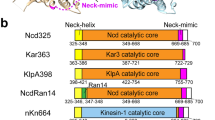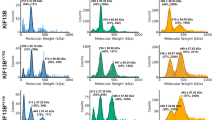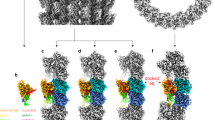Abstract
Molecular motors move directionally to either the plus or the minus end of microtubules or actin filaments. Kinesin moves towards microtubule plus ends, whereas the kinesin-related Ncd motor moves to the minus ends. The ‘neck’—the region between the stalk and motor domain—is required for Ncd to move to microtubule minus ends1,2, but the mechanism underlying directional motor movement is not understood. Here we show that a single amino-acid change in the Ncd neck causes the motor to reverse directions and move with wild-type velocities towards the plus or minus end; thus, the neck is functional but directionality is defective. Mutation of a motor-core residue that touches the neck residue in crystal structures2,3 also results in movement in both directions, indicating that directed movement to the minus end requires interactions of the neck and motor core. Low-density laser-trap assays show that a conformational change or working stroke of the Ncd motor is directional and biased towards the minus end, whereas that of the neck mutant occurs in either direction. We conclude that the directional bias of the working stroke is dependent on neck/motor core interactions. Absence of these interactions removes directional constraints and permits movement in either direction.
This is a preview of subscription content, access via your institution
Access options
Subscribe to this journal
Receive 51 print issues and online access
$199.00 per year
only $3.90 per issue
Buy this article
- Purchase on Springer Link
- Instant access to full article PDF
Prices may be subject to local taxes which are calculated during checkout




Similar content being viewed by others
References
Endow, S. A. & Waligora, K. W. Determinants of kinesin motor polarity. Science 281, 1200– 1202 (1998).
Sablin, E. P. et al. Direction determination in the minus-end-directed kinesin motor ncd. Nature 395, 813– 816 (1998).
Kozielski, F., De Bonis, S., Burmeister, W. P., Cohen-Addad, C. & Wade, R. H. The crystal structure of the minus-end-directed microtubule motor protein ncd reveals variable dimer conformations. Structure 7, 1407– 1416 (1999).
Hoyt, M. A., He, L., Totis, L. & Saunders, W. S. Loss of function of Saccharomyces cerevisiae kinesin-related CIN8 and KIP1 is suppressed by KAR3 motor domain mutations. Genetics 135, 35–44 ( 1993).
Endow, S. A. Determinants of molecular motor directionality. Nature Cell Biol. 1, 163–167 ( 1999). NB: See online version at http://www.nature.com/ncb/ for correct sequence alignment.
Iwatani, S., Iwane, A. H., Higuchi, H., Ishii, Y. & Yanagida, T. Mechanical and chemical properties of cysteine-modified kinesin molecules. Biochemistry 38, 10318–10323 (1999).
Svoboda, K. & Block, S. M. Force and velocity measured for single kinesin molecules. Cell 77, 773– 784 (1994).
Crevel, I. M. -T. C., Lockhart, A. & Cross, R. A. Weak and strong states of kinesin and ncd. J. Mol. Biol. 257, 66–76 (1996).
Walker, R. A., Salmon, E. D. & Endow, S. A. The Drosophila claret segregation protein is a minus-end directed motor molecule. Nature 347, 780–782 (1990).
Endow, S. A. in Guidebook to the Cytoskeletal and Motor Proteins (eds Kreis, T. & Vale, R.) 403–408 (Oxford Univ. Press, Oxford, 1999).
Kozielski, F. et al. The crystal structure of dimeric kinesin and implications for microtubule-dependent motility. Cell 91, 985–994 (1997).
Houdusse, A., Kalabokis, V. N., Himmel, D., Szent-Györgyi, A. G. & Cohen, C. Atomic structure of scallop myosin subfragment S1 complexed with MgADP: a novel conformation of the myosin head. Cell 14, 459– 470 (1999).
Wells, A. L. et al. Myosin VI is an actin-based motor that moves backwards. Nature 400, 505–508 ( 1999).
Chandra, R., Salmon, E. D., Erickson, H. P., Lockhart, A. & Endow, S. A. Structural and functional domains of the Drosophila ncd microtubule motor protein. J. Biol. Chem. 268, 9005–9013 ( 1993).
Way, M., Pope, P., Gooch, J., Hawkins, M. & Weeds, A. G. Identification of a region in segment 1 of gelsolin critical for actin binding. EMBO J. 9, 4103 –4109 (1990).
Chandra, R. & Endow, S. A. Expression of microtubule motor proteins in bacteria for characterization in in vitro motility assays. Methods Cell Biol. 39, 115– 127 (1993).
Hatsumi, M. & Endow, S. A. The Drosophila ncd microtubule motor protein is spindle-associated in meiotic and mitotic cells. J. Cell Sci. 103, 1013–1020 (1992).
Song, H., Golovkin, M., Reddy, A. S. N. & Endow, S. A. In vitro motility of AtKCBP, a calmodulin-binding kinesin protein of Arabidopsis. Proc. Natl Acad. Sci. USA 94, 322–327 (1997).
Acknowledgements
We thank L. Yamaguchi and Y. Toyoshima for fluorescently labelled axoneme–microtubules, and J. Howard and W. Schief for valuable discussions. This work was supported by the NIH (S.A.E.), Japan Ministry of Education, Science, Sport & Culture (H.H.) and Human Frontier Science Program (S.A.E. and H.H.).
Author information
Authors and Affiliations
Corresponding author
Rights and permissions
About this article
Cite this article
Endow, S., Higuchi, H. A mutant of the motor protein kinesin that moves in both directions on microtubules. Nature 406, 913–916 (2000). https://doi.org/10.1038/35022617
Received:
Accepted:
Issue Date:
DOI: https://doi.org/10.1038/35022617
This article is cited by
-
Characterization on a Novel Rolled Leaves and Short Petioles Soybean Mutant Based on Seq-BSA and RNA-seq Analysis
Journal of Plant Biology (2022)
-
Collective transient ratchet transport induced by many elastically interacting particles
Scientific Reports (2021)
-
An estimate to the first approximation of microtubule rupture force
European Biophysics Journal (2019)
-
The preprophase band-associated kinesin-14 OsKCH2 is a processive minus-end-directed microtubule motor
Nature Communications (2018)
-
The mitotic kinesin-14 KlpA contains a context-dependent directionality switch
Nature Communications (2017)
Comments
By submitting a comment you agree to abide by our Terms and Community Guidelines. If you find something abusive or that does not comply with our terms or guidelines please flag it as inappropriate.



